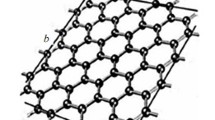Abstract
Graphene-based nanomaterials (GBNMs) are widely used in various industrial and biomedical applications. GBNMs of different compositions, size and shapes are being introduced without thorough toxicity evaluation due to the unavailability of regulatory guidelines. Computational toxicity prediction methods are used by regulatory bodies to quickly assess health hazards caused by newer materials. Due to increasing demand of GBNMs in various size and functional groups in industrial and consumer based applications, rapid and reliable computational toxicity assessment methods are urgently needed. In the present work, we investigate the impact of graphene and graphene oxide nanomaterials on the structural conformations of small hepcidin peptide and compare the materials for their structural and conformational changes. Our molecular dynamics simulation studies revealed conformational changes in hepcidin due to its interaction with GBMNs, which results in a loss of its functional properties. Our results indicate that hepcidin peptide undergo severe structural deformations when superimposed on the graphene sheet in comparison to graphene oxide sheet. These observations suggest that graphene is more toxic than a graphene oxide nanosheet of similar area. Overall, this study indicates that computational methods based on structural deformation, using molecular dynamics (MD) simulations, can be used for the early evaluation of toxicity potential of novel nanomaterials.










Similar content being viewed by others
References
Yoo E, Kim J, Hosono E et al (2008) Large reversible Li storage of graphene nanosheet families for use in rechargeable lithium ion batteries. Nano Lett 8:2277–2282. https://doi.org/10.1021/nl800957b
Kuila T, Bose S, Khanra P et al (2011) Recent advances in graphene-based biosensors. Biosens Bioelectron 26:4637–4648. https://doi.org/10.1016/j.bios.2011.05.039
Shen H, Zhang L, Liu M, Zhang Z (2012) Biomedical applications of graphene. Theranostics 2:283–294. https://doi.org/10.7150/thno.3642
Sreeprasad TS, Pradeep T (2012) Graphene for environmental and biological applications. Int J Mod Phys B 26:1242001. https://doi.org/10.1142/S0217979212420015
Bao H, Pan Y, Li L (2012) Recent advances in graphene-based nanomaterials for biomedical applications. Nano Life 2:1230001. https://doi.org/10.1142/S179398441100030X
Dreyer DR, Park S, Bielawski CW, Ruoff RS (2010) The chemistry of graphene oxide. Chem Soc Rev 39:228–240. https://doi.org/10.1039/b917103g
Shemetov AA, Nabiev I, Sukhanova A (2012) Molecular interaction of proteins and peptides with nanoparticles. ACS Nano 6:4585–4602. https://doi.org/10.1021/nn300415x
Leong W-I, Lönnerdal B (2004) Hepcidin, the recently identified peptide that appears to regulate iron absorption. J Nutr 134:1–4
Rossi E (2005) Hepcidin–the iron regulatory hormone. Clin Biochem Rev 26:47–49
Nemeth E, Ganz T (2009) The role of hepcidin in iron metabolism. Acta Haematol 122:78–86. https://doi.org/10.1159/000243791
Hunter HN, Fulton DB, Ganz T, Vogel HJ (2002) The solution structure of human hepcidin, a peptide hormone with antimicrobial activity that is involved in iron uptake and hereditary hemochromatosis. J Biol Chem 277:37597–37603. https://doi.org/10.1074/jbc.M205305200
Nemeth E, Preza GC, Jung CL et al (2006) The N-terminus of hepcidin is essential for its interaction with ferroportin: structure-function study. Blood 107:328–333. https://doi.org/10.1182/blood-2005-05-2049
Kemna EHJM., Tjalsma H, Willems HL, Swinkels DW (2008) Hepcidin: from discovery to differential diagnosis. Haematologica 93:90–97. https://doi.org/10.3324/haematol.11705
Jordan JB, Poppe L, Haniu M et al (2009) Hepcidin revisited, disulfide connectivity, dynamics, and structure. J Biol Chem 284:24155–24167. https://doi.org/10.1074/jbc.M109.017764
Girelli D, Nemeth E, Swinkels DW (2016) Hepcidin in the diagnosis of iron disorders. Blood 127:2809–2813. https://doi.org/10.1182/blood-2015-12-639112
Cenci L, Andreetto E, Vestri A et al (2015) Surface plasmon resonance based on molecularly imprinted nanoparticles for the picomolar detection of the iron regulating hormone Hepcidin-25. J Nanobiotechnol 13:51. https://doi.org/10.1186/s12951-015-0115-3
Baweja L, Balamurugan K, Subramanian V, Dhawan A (2013) Hydration patterns of graphene-based nanomaterials (GBNMs) play a major role in the stability of a helical protein: a molecular dynamics simulation study. Langmuir 29:14230–14238. https://doi.org/10.1021/la4033805
Oostenbrink C, Villa A, Mark AE, van Gunsteren WF (2004) A biomolecular force field based on the free enthalpy of hydration and solvation: the GROMOS force-field parameter sets 53A5 and 53A6. J Comput Chem 25:1656–1676. https://doi.org/10.1002/jcc.20090
Parrinello M (1981) Polymorphic transitions in single crystals: a new molecular dynamics method. J Appl Phys 52:7182. https://doi.org/10.1063/1.328693
Nosé S (1984) A unified formulation of the constant temperature molecular dynamics methods. J Chem Phys 81:511. https://doi.org/10.1063/1.447334
Bussi G, Donadio D, Parrinello M (2007) Canonical sampling through velocity rescaling. J Chem Phys 126:14101. https://doi.org/10.1063/1.2408420
Essmann U, Perera L, Berkowitz ML et al (1995) A smooth particle mesh Ewald method. J Chem Phys 103:8577. https://doi.org/10.1063/1.470117
Hess B, Bekker H, Berendsen HJC, Fraaije JGEM (1997) LINCS: a linear constraint solver for molecular simulations. J Comput Chem 18:1463–1472. https://doi.org/10.1002/(SICI)1096-987X(199709)18:12<1463::AID-JCC4>3.0.CO;2-H
Amadei A, Linssen ABM, Berendsen HJC (1993) Essential dynamics of proteins. Proteins Struct Funct Genet 17:412–425
van Aalten DM, Findlay JB, Amadei A, Berendsen HJ (1995) Essential dynamics of the cellular retinol-binding protein–evidence for ligand-induced conformational changes. Protein Eng 8:1129–1135
Yamaguchi H, van Aalten DM, Pinak M et al (1998) Essential dynamics of DNA containing a cis.syn cyclobutane thymine dimer lesion. Nucleic Acids Res 26:1939–1946
Kabsch W, Sander C (1983) Dictionary of protein secondary structure: pattern recognition of hydrogen-bonded and geometrical features. Biopolymers 22:2577–2637. https://doi.org/10.1002/bip.360221211
Guo J, Li J, Zhang Y et al (2013) Exploring the influence of carbon nanoparticles on the formation of β-sheet-rich oligomers of IAPP22–28 peptide by molecular dynamics simulation. PLoS ONE 8:e65579. https://doi.org/10.1371/journal.pone.0065579
García AE (1992) Large-amplitude nonlinear motions in proteins. Phys Rev Lett 68:2696–2699. https://doi.org/10.1103/PhysRevLett.68.2696
Nemeth E, Tuttle MS, Powelson J et al (2004) Hepcidin regulates cellular iron efflux by binding to ferroportin and inducing its internalization. Science 306:2090–2093. https://doi.org/10.1126/science.1104742
Acknowledgements
SKG and KPS acknowledge the Council of Scientific and Industrial Research (CSIR) India Network Projects GENESIS (BSC0121), NANOSHE (BSC0112) and INDEPTH (BSC0111). SKG and OW acknowledge University of Rostock, Rostock, Germany.
Author information
Authors and Affiliations
Corresponding author
Ethics declarations
Disclosure of interest
The authors report no conflicts of interest.
Additional information
Olaf Wolkenhauer, Qamar Rahman, Shailendra K. Gupta have contributed equally to this work.
Electronic supplementary material
Below is the link to the electronic supplementary material.
Rights and permissions
About this article
Cite this article
Singh, K.P., Baweja, L., Wolkenhauer, O. et al. Impact of graphene-based nanomaterials (GBNMs) on the structural and functional conformations of hepcidin peptide. J Comput Aided Mol Des 32, 487–496 (2018). https://doi.org/10.1007/s10822-018-0103-4
Received:
Accepted:
Published:
Issue Date:
DOI: https://doi.org/10.1007/s10822-018-0103-4




